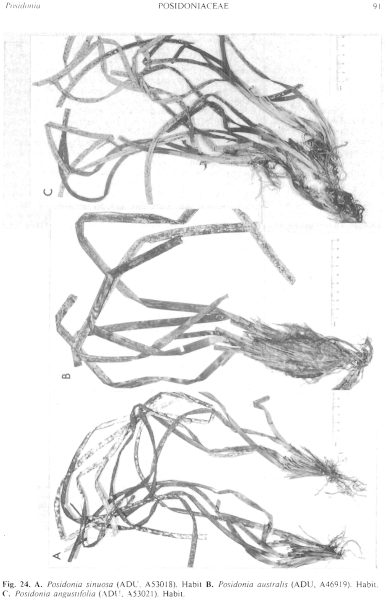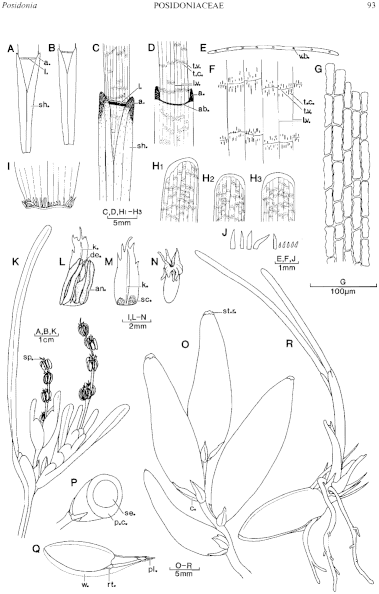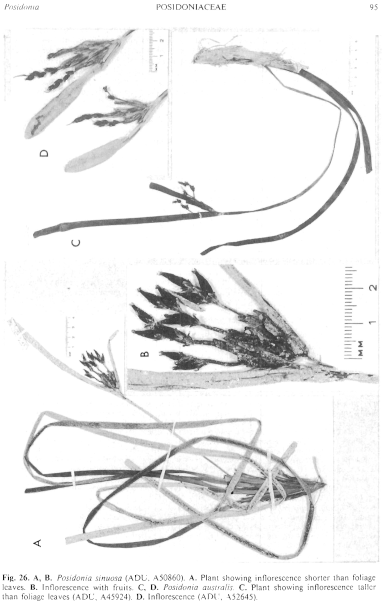|
|
|
|
|
|||||||||||
|
Electronic Flora of South Australia Species Fact Sheet
Phylum Magnoliophyta – Subphylum Seagrasses – Class Liliopsida – Subclass Alismatidae – Order Potamogetonales – Family Posidoniaceae
Selected citations: Green 1981: 5.
Rhizomes 3–8 mm thick, internodes 1–5 cm long, bearing short erect stems with very short internodes, crowded branches and numerous congested 1–2 leaved shoots, usually giving the appearance of discrete, tufted plants (Figs 24A, 26A). Leaves 1–2 per shoot; sheaths (Fig. 25A–D) 3–6 (–12) cm long, margins overlapping for about half their length, brown to dark reddish-brown in colour, remaining entire, not disintegrating into hair-like fibres, straw-like in texture when dry; ligule about 1 mm long; auricles 1–2 mm long, dark-brown; blade (Fig. 25C–F) linear, flat or somewhat concave-convex, lax, (20–) 25–50 (–120) cm long, 4–8 (–11) mm broad, longitudinal veins 8–11 (–13) uniting near the apex; epidermal cells (Fig. 25G) in surface view oblong, L/B 4–10, with sinuous margins; apices (Fig. 25H) rounded or truncate, frequently asymmetric. Squamules (Fig. 25I,J) lanceolate, 0.2–0.8 mm long. Inflorescence (Figs 25K, 26A,B) hidden beneath the canopy of leaves on a flat peduncle about 10 cm long, 2–4 mm broad; spikes 2–4 subtended by 2 bracts of unequal length, the longer one 6–25 cm long and exceeding the inflorescence; spike terminating in a short spur. Flowers (Fig. 25K) 3–6 per spike. Anthers deep red before dehiscence, connective (Fig. 25L,M) 4–6 mm tall, oblong-lanceolate, with a shallow keel, apex tridentate. Ovary (Fig. 25N) 4–5 mm tall; stigma irregularly dentate with 3–5 spurs. Fruit (Figs 250,P, 26B) ellipsoidal-terete, 2–3 cm long; seed (Fig. 25Q) ellipsoid, 1.5–2 cm long, ventral wing 2–3 mm wide, seed (Fig. 25R), remaining attached to the young plant for 1–2 years after germination.
Type from Point Atwick, Garden I., W. Aust., 3 m deep (Cambridge, 20.xi.1971); in PERTH.
Selected specimens: Safety Bay, (near Penguin I. spit), W. Aust., 1.5 m deep (Cambridge, 23.ix.1976; UWA, 2840 and ADU, A51181). Warnbro Sound, W. Aust., 2 m deep (Cambridge, 26.x.1978; ADU, A50860). Main Bay, Pearson I., S. Aust., 7–10 m deep (Shepherd & Turner, 28.iii.1982; ADU, A53018). Tiparra reef, Spencer Gulf, S. Aust., 8 m deep (Shepherd, 12.i.1978; ADU, A49410). West I., Encounter Bay, S. Aust., 5 m deep (Shepherd, 28.xii.1973; ADU, A45288). Kingston, S. Aust., 6 m deep (Shepherd, 21.iii.1974; ADU, A46462).
Distribution: From Shark Bay, W. Aust. around western and southern Australia to Kingston, S. Aust. P. sinuosa is widely distributed to a depth of 15 m in bays and other sheltered areas either in pure stands or growing sympatrically with P. australis or P. angustifolia. In more exposed areas it may form meadows with Amphibolis spp. The rhizome of P. sinuosa is firmly rooted in the substrate and usually only removed with great difficulty.
References:
CAMBRIDGE, M.L. & KUO, J. (1979). Two new species of seagrasses from Australia, Posidonia sinuosa and P. angustifolia (Posidoniaceae). Aquat. Bot, 6, 307–328.
GREEN, J.W. (1981). Census of the Vascular Plants of Western Australia. (Western Australian Herbarium: South Perth.)
The Marine Benthic Flora of Southern Australia Part I complete list of references.
Publication:
Womersley, H.B.S. (31 May, 1984)
The Marine Benthic Flora of Southern Australia
Part I
©Board of the Botanic Gardens and State Herbarium, Government of South Australia
Illustrations in Womersley Part I, 1984: FIGS 24A, 25, 26A,B.

Figure 24 enlarge
Fig. 24. A. Posidonia sinuosa (ADU, A53018). Habit B. Posidonia australis (ADU, A46919). Habit. C. Posidonia angustifolia (ADU, A53021). Habit.

Figure 25 enlarge
Fig. 25. A–R. Posidonia sinuosa. A, B. Leaf sheath (sh.) (adaxial view) with auricles (a.) and ligule (I.) showing variation in amount of margin overlap. C. Portion of leaf (adaxial view). Junction of blade and sheath (sh.) showing auricles (a.), ligule (l.), longitudinal veins and transverse veins. D. Portion of leaf (abaxial view). Junction of blade and sheath showing auricles (a.), longitudinal (I.v.) and transverse (t.v.) veins, tannin cells (t.c.) and abscission line (ab.). E. T.S. mid portion of leaf blade showing vascular bundles (v.b.). F. Portion of leaf blade showing tannin cells (t.c.) accumulated either side of transverse veins (t.v.) G. Epidermis of leaf blade (surface view) showing sinuose margins of epidermal cells. H1-H3. Leaf apices showing venation. I. Squamules in position adhering to base of sheath. J. Squamules showing variation in size. K. Inflorescence of 2 spikes showing terminal spur (sp.). L. Stamen (abaxial view) showing 2 bilocular anthers (an.) (dehisced), line of dehiscence (co.) and elongated connective with keel (k.). M. Connective (abaxial view) after anthers have fallen showing scar (sc.). N. Ovary and lobed stigma. 0. Spike of 4 fruits with persistent anther connectives (c.). and stigma remnant (st.r.). P. T.S. fruit showing pericarp (p.c.) and seed (se.). Q. Seed showing ventral wing (w.), emerging root (rt.) and plumule (pl.). R. Young plant remaining attached to seed. (A–J from ADU, A49410. K–N from ADU, A51181. O–Q from ADU, A45288. R from ADU, A46462.)

Figure 26 enlarge
Fig. 26. A, B. Posidonia sinuosa (ADU, A50860). A. Plant showing inflorescence shorter than foliage leaves. B. Inflorescence with fruits. C, D. Posidonia australis. C. Plant showing inflorescence taller than foliage leaves (ADU, A45924). D. Inflorescence (ADU, A52645).

|
Email Contact: State Herbarium of South Australia |

|